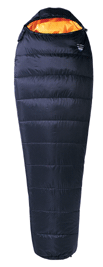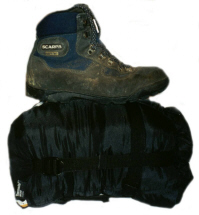
On test...
Wynnster Microlite 1200 sleeping bag
By Colin Hogarth

With summer upon us, I decided the time had finally come to splash out on a two to three season sleeping bag. For years I've been trekking about the country with a rather ageing, weighty and now somewhat smelly Vango Icelandic lashed to my back. The faithful old bag has stood the test of time well, but it's too warm and, frankly, bulky for spring and summer backpacking.
So, clutching a couple of Christmas gift vouchers, I headed off to my nearest Tiso store to meet my new sleeping partner. After weighing up the options, I plumped for a Wynnster Microlite 1200. At £60, it was a good deal cheaper than the alternatives. But I've been impressed by other Wynnster products, so, after comparing various specs, I decided to give it a go.
The Microlite 1200's first outings were during late April and early May when we had a few hot days, followed by some pretty cold nights. I took it to Glencoe, the island of Rum and Arrochar and it didn't let me down once, even with temperatures dipping below zero on occasion.
The 1200 is the top of the Microlite range and promises to perform down to minus 10, although temperature rating figures are not an exact science, as Wynnster themselves point out. These things are subject to other factors, such as your own metabolism and what clothing you may be wearing to bed. It's a guideline, rather than a guarantee.

The first thing you notice about the 1200 is it comes off the shelf in a nice compact bundle, about half the size of my winter sleeping bag, which is good for a synthetic fill. It's not the smallest and lightest sleeping bag in the world but, for the price, it's very good. The bag comes with its own compression stuff sack although, as with all sleeping bags, it's a bugger to get it back in neatly!
The 1200, like three out of the four Microlite bags in the range, is filled with DuPont Thermolite Micro, sealed within a soft, lightweight ripstop nylon shell with ripstop nylon lining. The insulation is as soft as down and the fibres are finer than silk, trapping large quantities of air to provide maximum insulation.
Once you pull it out of its stuff sack, you find it's a good, roomy bag. The outer and inner fabric is very comfortable and warm, the nylon offering a smooth, almost silky feel. A two-way zip runs the length of the bag, good for ventilation. There's a thermal zip-baffle and a tape running the length of the zip, designed to stop it snagging.
The bag has a shaped drawcord hood, which pulls in nice and tight, and a feature I particularly liked is the padded drawcord chest tunnel within the bag, which leaves you feeling very snug. The bag is thicker on top than bottom. It has two 150g layers of fibre on the top and one layer on the underside, which works well.
For someone of average height and slim build I found the 1200 a spacious sack, which would comfortably accommodate even fairly bulky/tall people.
So how did it perform? In short, very well indeed. I slept soundly through some cold spring nights, wearing just underwear inside the bag. Not once did I feel even a tiny bit cold, even when I was woken at 4am by a sheep scuffling round outside the tent. Overall, the Microlite 1200 is comfortable and roomy, performed superbly and, for a synthetic bag, was very light and compact to carry. It's excellent value for money and proved to be a very good buy.
Wynnster Microlite range specifications
Model |
Temp rating |
Insulation |
Weight |
Dimensions (cm) |
Shell colour |
| Microlite 600 | 5°C | Micro polyester | 0.70kg | 215 x 80 x 50 | Red |
| Microlite 750 | 0°C | DuPont Thermolite Micro | 0.85kg | 215 x 80 x 50 | Navy |
| Microlite 950 | -5°C | DuPont Thermolite Micro | 1.10kg | 215 x 80 x 50 | Cobalt |
| Microlite 1200 | -10°C | DuPont Thermolite Micro | 1.35kg | 215 x 80 x 50 | Black |
For more information on the Wynnster range, log on to www.wynnster.co.uk